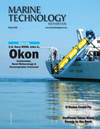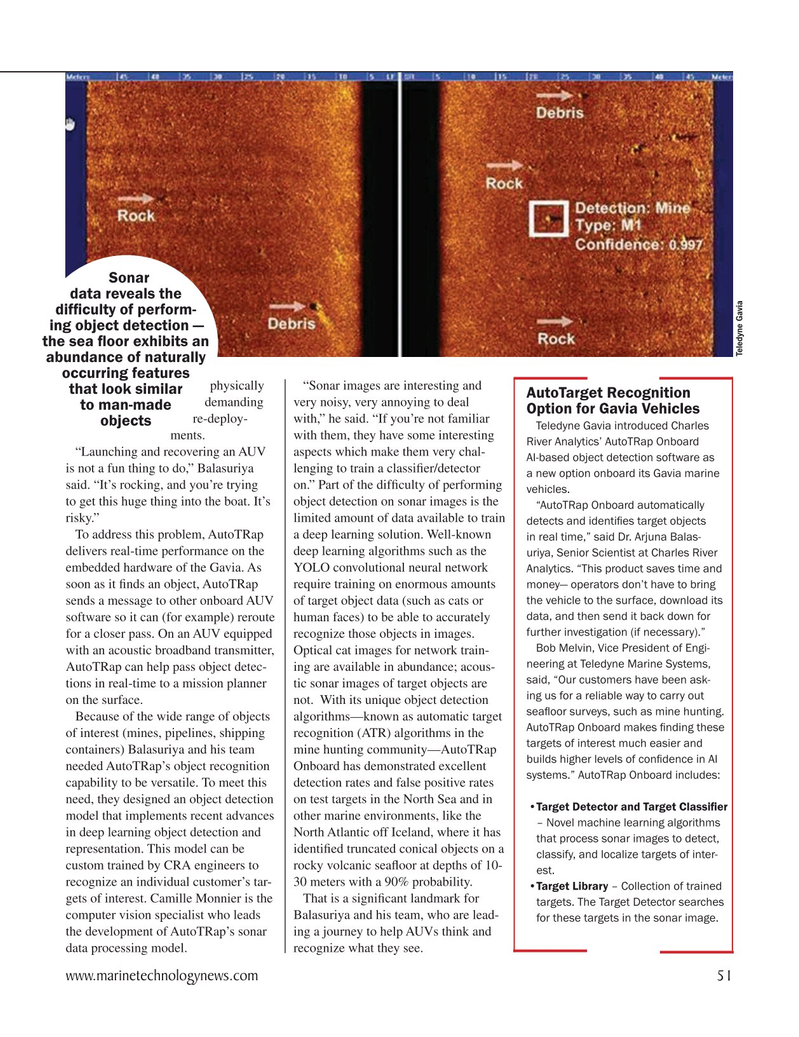
Page 51: of Marine Technology Magazine (October 2020)
Read this page in Pdf, Flash or Html5 edition of October 2020 Marine Technology Magazine
Sonar data reveals the dif? culty of perform- ing object detection — the sea ? oor exhibits an
Teledyne Gavia abundance of naturally occurring features physically “Sonar images are interesting and that look similar
AutoTarget Recognition demanding very noisy, very annoying to deal to man-made
Option for Gavia Vehicles re-deploy- with,” he said. “If you’re not familiar objects
Teledyne Gavia introduced Charles ments. with them, they have some interesting
River Analytics’ AutoTRap Onboard “Launching and recovering an AUV aspects which make them very chal-
AI-based object detection software as is not a fun thing to do,” Balasuriya lenging to train a classi? er/detector a new option onboard its Gavia marine said. “It’s rocking, and you’re trying on.” Part of the dif? culty of performing vehicles. to get this huge thing into the boat. It’s object detection on sonar images is the “AutoTRap Onboard automatically risky.” limited amount of data available to train detects and identi? es target objects
To address this problem, AutoTRap a deep learning solution. Well-known in real time,” said Dr. Arjuna Balas- delivers real-time performance on the deep learning algorithms such as the uriya, Senior Scientist at Charles River embedded hardware of the Gavia. As YOLO convolutional neural network
Analytics. “This product saves time and soon as it ? nds an object, AutoTRap require training on enormous amounts money— operators don’t have to bring the vehicle to the surface, download its sends a message to other onboard AUV of target object data (such as cats or data, and then send it back down for software so it can (for example) reroute human faces) to be able to accurately further investigation (if necessary).” for a closer pass. On an AUV equipped recognize those objects in images.
Bob Melvin, Vice President of Engi- with an acoustic broadband transmitter, Optical cat images for network train- neering at Teledyne Marine Systems,
AutoTRap can help pass object detec- ing are available in abundance; acous- said, “Our customers have been ask- tions in real-time to a mission planner tic sonar images of target objects are ing us for a reliable way to carry out on the surface. not. With its unique object detection sea? oor surveys, such as mine hunting.
Because of the wide range of objects algorithms—known as automatic target
AutoTRap Onboard makes ? nding these of interest (mines, pipelines, shipping recognition (ATR) algorithms in the targets of interest much easier and containers) Balasuriya and his team mine hunting community—AutoTRap builds higher levels of con? dence in AI needed AutoTRap’s object recognition Onboard has demonstrated excellent systems.” AutoTRap Onboard includes: capability to be versatile. To meet this detection rates and false positive rates need, they designed an object detection on test targets in the North Sea and in • Target Detector and Target Classi? er model that implements recent advances other marine environments, like the – Novel machine learning algorithms in deep learning object detection and North Atlantic off Iceland, where it has that process sonar images to detect, representation. This model can be identi? ed truncated conical objects on a classify, and localize targets of inter- custom trained by CRA engineers to rocky volcanic sea? oor at depths of 10- est. recognize an individual customer’s tar- 30 meters with a 90% probability.
• Target Library – Collection of trained gets of interest. Camille Monnier is the That is a signi? cant landmark for targets. The Target Detector searches computer vision specialist who leads Balasuriya and his team, who are lead- for these targets in the sonar image.
the development of AutoTRap’s sonar ing a journey to help AUVs think and data processing model. recognize what they see.
www.marinetechnologynews.com 51
MTR #8 (50-63).indd 51 10/9/2020 11:08:19 AM

 50
50

 52
52
